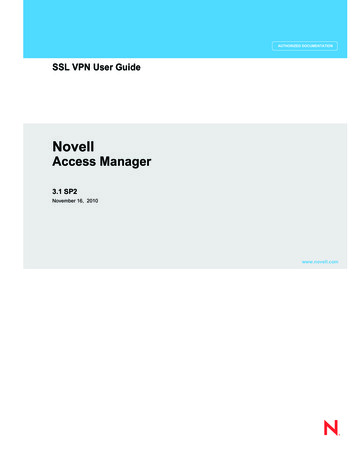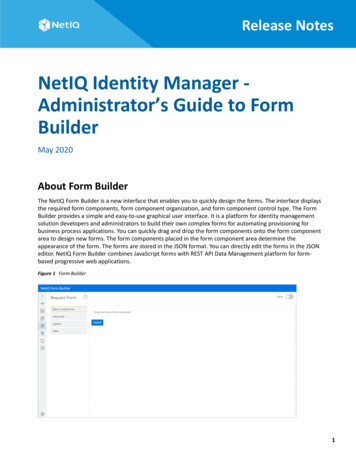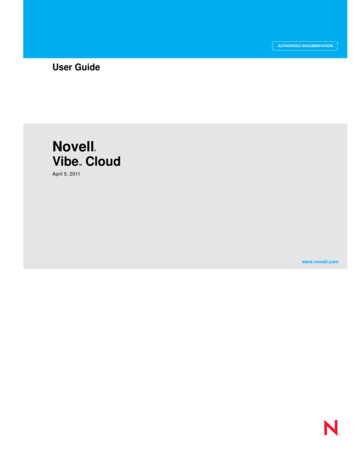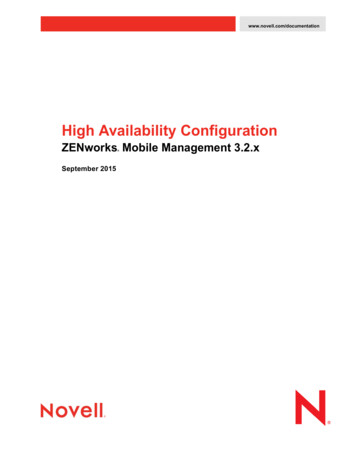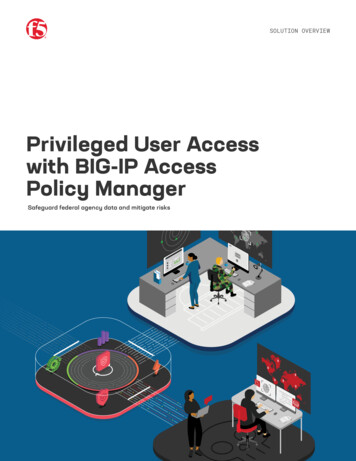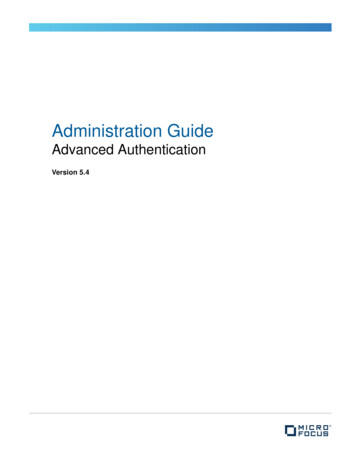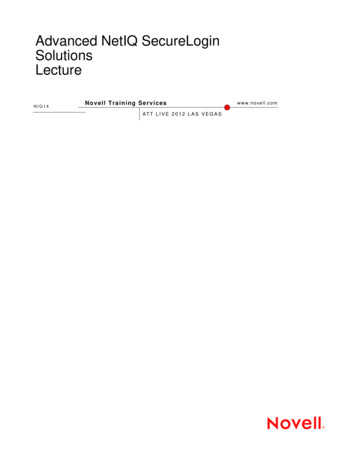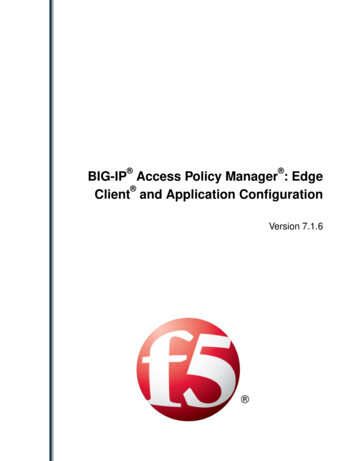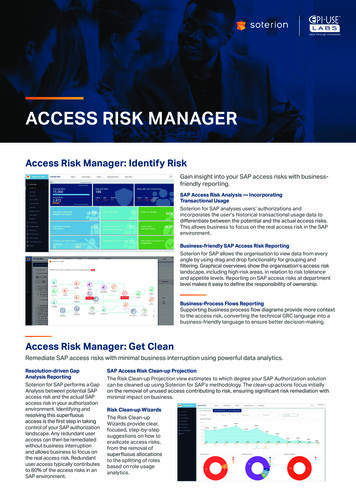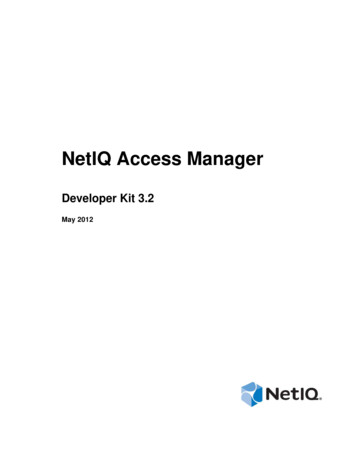
Transcription
NetIQ Access ManagerDeveloper Kit 3.2May 2012
Legal NoticeTHIS DOCUMENT AND THE SOFTWARE DESCRIBED IN THIS DOCUMENT ARE FURNISHED UNDER AND ARESUBJECT TO THE TERMS OF A LICENSE AGREEMENT OR A NON‐DISCLOSURE AGREEMENT. EXCEPT AS EXPRESSLYSET FORTH IN SUCH LICENSE AGREEMENT OR NON‐DISCLOSURE AGREEMENT, NETIQ CORPORATION PROVIDESTHIS DOCUMENT AND THE SOFTWARE DESCRIBED IN THIS DOCUMENT ʺAS ISʺ WITHOUT WARRANTY OF ANYKIND, EITHER EXPRESS OR IMPLIED, INCLUDING, BUT NOT LIMITED TO, THE IMPLIED WARRANTIES OFMERCHANTABILITY OR FITNESS FOR A PARTICULAR PURPOSE. SOME STATES DO NOT ALLOW DISCLAIMERS OFEXPRESS OR IMPLIED WARRANTIES IN CERTAIN TRANSACTIONS; THEREFORE, THIS STATEMENT MAY NOT APPLYTO YOU.This document and the software described in this document may not be lent, sold, or given away without the prior writtenpermission of NetIQ Corporation, except as otherwise permitted by law. Except as expressly set forth in such licenseagreement or non‐disclosure agreement, no part of this document or the software described in this document may bereproduced, stored in a retrieval system, or transmitted in any form or by any means, electronic, mechanical, or otherwise,without the prior written consent of NetIQ Corporation. Some companies, names, and data in this document are used forillustration purposes and may not represent real companies, individuals, or data.This document could include technical inaccuracies or typographical errors. Changes are periodically made to theinformation herein. These changes may be incorporated in new editions of this document. NetIQ Corporation may makeimprovements in or changes to the software described in this document at any time. 2012 NetIQ Corporation and its affiliates. All Rights Reserved.U.S. Government Restricted Rights: If the software and documentation are being acquired by or on behalf of the U.S.Government or by a U.S. Government prime contractor or subcontractor (at any tier), in accordance with 48 C.F.R. 227.7202‐4(for Department of Defense (DOD) acquisitions) and 48 C.F.R. 2.101 and 12.212 (for non‐DOD acquisitions), the government’srights in the software and documentation, including its rights to use, modify, reproduce, release, perform, display or disclosethe software or documentation, will be subject in all respects to the commercial license rights and restrictions provided in thelicense agreement.Check Point, FireWall‐1, VPN‐1, Provider‐1, and SiteManager‐1 are trademarks or registered trademarks of Check PointSoftware Technologies Ltd.Access Manager, ActiveAudit, ActiveView, Aegis, AppManager, Change Administrator, Change Guardian, Cloud Manager,Compliance Suite, the cube logo design, Directory and Resource Administrator, Directory Security Administrator, DomainMigration Administrator, Exchange Administrator, File Security Administrator, Group Policy Administrator, Group PolicyGuardian, Group Policy Suite, IntelliPolicy, Knowledge Scripts, NetConnect, NetIQ, the NetIQ logo, PlateSpin, PlateSpinRecon, Privileged User Manager, PSAudit, PSDetect, PSPasswordManager, PSSecure, Secure Configuration Manager, SecurityAdministration Suite, Security Manager, Server Consolidator, VigilEnt, and Vivinet are trademarks or registered trademarksof NetIQ Corporation or its affiliates in the USA. All other company and product names mentioned are used only foridentification purposes and may be trademarks or registered trademarks of their respective companies.For purposes of clarity, any module, adapter or other similar material (ʺModuleʺ) is licensed under the terms and conditions ofthe End User License Agreement for the applicable version of the NetIQ product or software to which it relates orinteroperates with, and by accessing, copying or using a Module you agree to be bound by such terms. If you do not agree tothe terms of the End User License Agreement you are not authorized to use, access or copy a Module and you must destroy allcopies of the Module and contact NetIQ for further instructions.
ContentsAbout This Guide51 Getting Started1.11.27Development Overview . . . . . . . . . . . . . . . . . . . . . . . . . . . . . . . . . . . . . . . . . . . . . . . . . . . . . . . . . . . . 71.1.1SDK Components . . . . . . . . . . . . . . . . . . . . . . . . . . . . . . . . . . . . . . . . . . . . . . . . . . . . . . . . . 71.1.2Additional Information . . . . . . . . . . . . . . . . . . . . . . . . . . . . . . . . . . . . . . . . . . . . . . . . . . . . . . 8Selecting an Integrated Development Environment . . . . . . . . . . . . . . . . . . . . . . . . . . . . . . . . . . . . . . . 82 Identity Server Authentication API2.12.22.32.42.52.69Prerequisites . . . . . . . . . . . . . . . . . . . . . . . . . . . . . . . . . . . . . . . . . . . . . . . . . . . . . . . . . . . . . . . . . . . . 9Understanding the Authentication Class . . . . . . . . . . . . . . . . . . . . . . . . . . . . . . . . . . . . . . . . . . . . . . . 92.2.1Authentication Class Components. . . . . . . . . . . . . . . . . . . . . . . . . . . . . . . . . . . . . . . . . . . . . 92.2.2How the Authentication Class Operates . . . . . . . . . . . . . . . . . . . . . . . . . . . . . . . . . . . . . . . 10Creating an Authentication Class . . . . . . . . . . . . . . . . . . . . . . . . . . . . . . . . . . . . . . . . . . . . . . . . . . . . 112.3.1Project Requirements . . . . . . . . . . . . . . . . . . . . . . . . . . . . . . . . . . . . . . . . . . . . . . . . . . . . . 112.3.2The doAuthenticate Method. . . . . . . . . . . . . . . . . . . . . . . . . . . . . . . . . . . . . . . . . . . . . . . . . 112.3.3Authentication Methods . . . . . . . . . . . . . . . . . . . . . . . . . . . . . . . . . . . . . . . . . . . . . . . . . . . . 132.3.4Class Property Methods . . . . . . . . . . . . . . . . . . . . . . . . . . . . . . . . . . . . . . . . . . . . . . . . . . . 142.3.5Status Methods . . . . . . . . . . . . . . . . . . . . . . . . . . . . . . . . . . . . . . . . . . . . . . . . . . . . . . . . . . 182.3.6User Information Methods . . . . . . . . . . . . . . . . . . . . . . . . . . . . . . . . . . . . . . . . . . . . . . . . . . 192.3.7Other Methods . . . . . . . . . . . . . . . . . . . . . . . . . . . . . . . . . . . . . . . . . . . . . . . . . . . . . . . . . . . 20Understanding the Authentication Class Example . . . . . . . . . . . . . . . . . . . . . . . . . . . . . . . . . . . . . . . 212.4.1Extending the Base Authentication Class . . . . . . . . . . . . . . . . . . . . . . . . . . . . . . . . . . . . . . 212.4.2Implementing the doAuthenticate Method . . . . . . . . . . . . . . . . . . . . . . . . . . . . . . . . . . . . . . 212.4.3Prompting for Credentials . . . . . . . . . . . . . . . . . . . . . . . . . . . . . . . . . . . . . . . . . . . . . . . . . . 212.4.4Verifying Credentials . . . . . . . . . . . . . . . . . . . . . . . . . . . . . . . . . . . . . . . . . . . . . . . . . . . . . . 222.4.5PasswordClass Example Code . . . . . . . . . . . . . . . . . . . . . . . . . . . . . . . . . . . . . . . . . . . . . . 22Localizing the Prompts in Your Authentication Class. . . . . . . . . . . . . . . . . . . . . . . . . . . . . . . . . . . . . 242.5.1Creating a Properties File . . . . . . . . . . . . . . . . . . . . . . . . . . . . . . . . . . . . . . . . . . . . . . . . . . 242.5.2Creating a Resource Class . . . . . . . . . . . . . . . . . . . . . . . . . . . . . . . . . . . . . . . . . . . . . . . . . 252.5.3Creating or Modifying a JSP Page. . . . . . . . . . . . . . . . . . . . . . . . . . . . . . . . . . . . . . . . . . . . 25Deploying Your Authentication Class . . . . . . . . . . . . . . . . . . . . . . . . . . . . . . . . . . . . . . . . . . . . . . . . . 263 LDAP Server Plug-In3.13.23.33.43.529Prerequisites . . . . . . . . . . . . . . . . . . . . . . . . . . . . . . . . . . . . . . . . . . . . . . . . . . . . . . . . . . . . . . . . . . . 29Creating the LDAP Plug-In . . . . . . . . . . . . . . . . . . . . . . . . . . . . . . . . . . . . . . . . . . . . . . . . . . . . . . . . . 29eDirectory Plug-In . . . . . . . . . . . . . . . . . . . . . . . . . . . . . . . . . . . . . . . . . . . . . . . . . . . . . . . . . . . . . . . 31Installing and Configuring the LDAP Plug-In . . . . . . . . . . . . . . . . . . . . . . . . . . . . . . . . . . . . . . . . . . . 34Troubleshooting . . . . . . . . . . . . . . . . . . . . . . . . . . . . . . . . . . . . . . . . . . . . . . . . . . . . . . . . . . . . . . . . . 354 The Policy Extension API4.14.237Getting Started . . . . . . . . . . . . . . . . . . . . . . . . . . . . . . . . . . . . . . . . . . . . . . . . . . . . . . . . . . . . . . . . . . 374.1.1Prerequisites . . . . . . . . . . . . . . . . . . . . . . . . . . . . . . . . . . . . . . . . . . . . . . . . . . . . . . . . . . . . 374.1.2Types of Policy Extensions . . . . . . . . . . . . . . . . . . . . . . . . . . . . . . . . . . . . . . . . . . . . . . . . . 384.1.3How the Policy Engine Interacts with an Extension . . . . . . . . . . . . . . . . . . . . . . . . . . . . . . 38Common Elements and Tasks . . . . . . . . . . . . . . . . . . . . . . . . . . . . . . . . . . . . . . . . . . . . . . . . . . . . . . 424.2.1Implementing Common Elements . . . . . . . . . . . . . . . . . . . . . . . . . . . . . . . . . . . . . . . . . . . . 42Contents3
4.34.44.54.2.2Initializing the Factory Object. . . . . . . . . . . . . . . . . . . . . . . . . . . . . . . . . . . . . . . . . . . . . . . . 434.2.3Retrieving Information from the Identity Server User Store . . . . . . . . . . . . . . . . . . . . . . . . . 444.2.4Implementing the Extension Interface . . . . . . . . . . . . . . . . . . . . . . . . . . . . . . . . . . . . . . . . . 45Creating an Extension . . . . . . . . . . . . . . . . . . . . . . . . . . . . . . . . . . . . . . . . . . . . . . . . . . . . . . . . . . . . 504.3.1Creating a Context Data Extension . . . . . . . . . . . . . . . . . . . . . . . . . . . . . . . . . . . . . . . . . . . 504.3.2Creating a Condition Extension . . . . . . . . . . . . . . . . . . . . . . . . . . . . . . . . . . . . . . . . . . . . . . 544.3.3Creating an Action Extension . . . . . . . . . . . . . . . . . . . . . . . . . . . . . . . . . . . . . . . . . . . . . . . 57Installing and Configuring an Extension . . . . . . . . . . . . . . . . . . . . . . . . . . . . . . . . . . . . . . . . . . . . . . . 594.4.1Installing the Extension on the Administration Console . . . . . . . . . . . . . . . . . . . . . . . . . . . . 594.4.2Distributing a Policy Extension to Access Manager Devices . . . . . . . . . . . . . . . . . . . . . . . . 614.4.3Distributing the Extension to Customers . . . . . . . . . . . . . . . . . . . . . . . . . . . . . . . . . . . . . . . 62Sample Codes . . . . . . . . . . . . . . . . . . . . . . . . . . . . . . . . . . . . . . . . . . . . . . . . . . . . . . . . . . . . . . . . . . 624.5.1Data Extension for External Attribute Source Policy . . . . . . . . . . . . . . . . . . . . . . . . . . . . . . 624.5.2Template Policy Extensions. . . . . . . . . . . . . . . . . . . . . . . . . . . . . . . . . . . . . . . . . . . . . . . . . 634.5.3LDAP Group Data Element . . . . . . . . . . . . . . . . . . . . . . . . . . . . . . . . . . . . . . . . . . . . . . . . . 634.5.4PasswordClass . . . . . . . . . . . . . . . . . . . . . . . . . . . . . . . . . . . . . . . . . . . . . . . . . . . . . . . . . . 63A Revisions4NetIQ Access Manager 3.2 Developer Kit65
About This GuideThis document explains how to incorporate various security management features of NetIQ AccessManager with your proprietary applications. Unlike many software development kits (SDKs) thatrely on application programming interfaces to expose application functionality, this componentprimarily leverages how Access Manager extends existing Liberty Alliance, OASIS, SAML, and otherspecifications in defining and exchanging user identities.This document will be updated as new functionality is released for developers to enhance thecapabilities of Access Manager with your own applications and Web services.This document is divided into the following sections: Chapter 1, “Getting Started,” on page 7 Chapter 2, “Identity Server Authentication API,” on page 9 Chapter 3, “LDAP Server Plug‐In,” on page 29 Chapter 4, “The Policy Extension API,” on page 37AudienceThe audience for this documentation includes advanced network security software engineers andexperienced network administrators who understand the Liberty Alliance, Java* development, andsecure networking issues to enforce the security requirements the Liberty Alliance.Specifically, you should have advanced understanding of Internet protocols such as: Extensible Markup Language (XML) Simple Object Access Protocol (SOAP) Security Assertion Markup Language (SAML) Public Key Infrastructure (PKI) digital signature concepts and Internet security Secure Socket Layer/Transport Layer Security (SSL/TSL) Hypertext Transfer Protocol (HTTP and HTTPS) Uniform Resource Identifiers (URIs) Domain Name System (DNS) Web Services Description Language (WSDL)User CommentsWe want to hear your comments and suggestions about this manual and the other documentationincluded with this product. Please use the User Comments feature at the bottom of each page of theonline documentation.Additional Documentation NetIQ Access Manager Installation GuideAbout This Guide5
NetIQ Access Manager Setup Guide NetIQ Access Manager Administration GuideAdditional InformationUse the following sources to obtain more information on how to use this SDK: Post a message and view responses on the Access Manager Developer Support Forum discussion‐forums/access‐manager/) Use a news feed and reader to access the same forum: etIQ Access Manager 3.2 Developer Kit
1Getting Started1NetIQ Access Manager provides a component‐based framework for building secure federatedidentity network applications based on Liberty Alliance project standards. This framework isdesigned to help developers make a rapid transition into Liberty’s architecture.The Liberty components enable the convenience of single sign‐on and secure business‐to‐employee,business‐to‐customer, and business‐to‐business relationships across a variety of applications within atrusted Web services model. All components are standards‐based and designed for maximuminteroperability.This section explains how to get started with the Access Manager SDK and contains the followingtopics: Section 1.1, “Development Overview,” on page 7 Section 1.2, “Selecting an Integrated Development Environment,” on page 81.1Development OverviewThis SDK describes how to design a flexible and expandable access management system to enableyour applications to interact with the identity management capabilities of Access Manager, includingfederation, provisioning, and the secure delivery of identity information (user name and password,and X.509 certificates) to client‐based applications.The SDK is designed for those who want to develop new applications or integrate existingapplications with the standards‐based security architecture of Access Manager. It allows NetIQpartners and third‐party developers to do the following: Leverage the identity management and policy capabilities of the product. Provide access to various product features, including: Liberty‐based federated identity Secure credential exchange User provisioning services Authentication and authorization methods and policies SAML assertion generation and processingNOTE: To coordinate the development of Liberty‐enabled access management applications withinthe NetIQ industry framework, contact namsdk@novell.com.1.1.1SDK ComponentsThe Access Manager developer components are included in the Novell Access Manager DeveloperKit (http://www.novell.com/developer/ndk/novell access manager developer tools and examples.html). However, the complete AccessGetting Started7
Manager package, including the install, is not included in the NDK. For complete current productinformation, see the NetIQ Access Manager Product Site .The SDK does not include the JAR files required from the product to compile your extension. Youneed access to an Access Manager installation to obtain these files. For an evaluation version, seeNovell Downloads (http://download.novell.com/index.jsp) and search for Access Manager.1.1.2Additional InformationFor more information about Access Manager and other related NetIQ security products, see thefollowing links: NetIQ Access Manager Installation Guide anager32/installation/data/bookinfo.html) NetIQ Access Manager Setup Guide anager32/basicconfig/data/bookinfo.html) NetIQ Access Manager Administration Console Guide anager32/adminconsolehelp/data/bookinfo.html) Identity Server Guide anager32/identityserverhelp/data/bookinfo.html) Access Gateway Guide electing an Integrated Development EnvironmentThe Java applications can be developed on a number of open source IDEs such as Eclipse* andNetBeans*.8NetIQ Access Manager 3.2 Developer Kit
2Identity Server Authentication API2This section documents how to create a custom authentication class for the Identity Server. The APIpresented here allows developers to leverage their own authentication mechanisms within theAccess Manager architecture. The following topics are covered: Section 2.1, “Prerequisites,” on page 9 Section 2.2, “Understanding the Authentication Class,” on page 9 Section 2.3, “Creating an Authentication Class,” on page 11 Section 2.4, “Understanding the Authentication Class Example,” on page 21 Section 2.5, “Localizing the Prompts in Your Authentication Class,” on page 24 Section 2.6, “Deploying Your Authentication Class,” on page 262.1Prerequisites Access Manager 3.2. Your development environment requires the same installation as outlined in the “NetIQ AccessManager Installation Requirements” anager32/installation/data/b1rreuv.html). Copy the nidp.jar and NAMCommon.jar files in the following directory of your Identity Serverto your development project: On Linux: /opt/novell/nam/idp/webapps/nidp/WEB-INF/lib On Windows: C:\Program Files erstanding the Authentication ClassBefore developing an authentication class, review the following concepts: Section 2.2.1, “Authentication Class Components,” on page 9 Section 2.2.2, “How the Authentication Class Operates,” on page 102.2.1Authentication Class ComponentsThe Identity Server is the central authentication and identity access point for all services performedby Access Manager. The Identity Server supports numerous ways for users to authenticate. Theseinclude name/password, RADIUS token‐based authentication, and X.509 digital certificates.For more detailed information about the Identity Server and its relation to other Access Managercomponents, see “Identity Servers” anager32/installation/data/b6jju7o.html#b6jjxcx) in the NetIQ Access Manager Installation Guide.Identity Server Authentication API9
The configuration and interaction of the following entities defines how authentication takes placewithin Identity Server: User Stores: The LDAP directory that stores the user credentials. Access Manager can beconfigured to use the following directories: eDirectory , Active Directory*, or Sun One*. Usersset up their user stores when creating the Identity Server configuration. Authentication Classes: The code (a Java class) that implements a particular authentication type(name/password, RADIUS
Chapter 2, “Identity Server Authentication API,” on page 9 Chapter 3, “LDAP Server Plug‐In,” on page 29 Chapter 4, “The Policy Extension API,” on page 37 Audience The audience for this documentation includes
